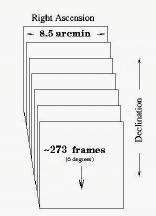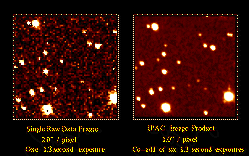III. 2MASS Facilities and Operations
2. Data Acquisition
a. Scanning Strategy
The 2MASS arrays image the sky while the telescope scans smoothly in declination at a rate of 57" per second. The telescope scans are designed to cover "tiles" 6° long in the declination direction and one camera frame (8.5') wide in right ascension. While the entire telescope scans in the declination direction at a constant right ascension, the telescope's secondary mirror tilts opposite the scan direction to momentarily freeze the focal plane image. At the end of each Reset-Read-Read cycle described in Section III.1.b, the secondary flies back to its start position and freezes a new piece of sky displaced by about 1/6 frame from the previous frame. The dead-time between frames is less than 0.1 sec, and is used for for secondary flyback and array reset. When accounting for this dead-time and the time to point the telescope and initiate a scan, the 2MASS observing system integrates on sky approximately 84% of each night. This movie shows several consecutive frames from a scan through the globular cluster M92.
The camera field-of-view shifts by approximately one-sixth of a frame in declination from frame-to-frame. Figure 1 illustrates the relationship between individual camera frames and survey tiles. The camera images each point on the sky six times for a total integration time of 7.8 sec. The scan rate (and, thus, the frame-to-frame declination offset) and array orientation are set, so that each of the six apparitions of a given star occur at a different location relative to a pixel center. This sub-pixel "dithering" improves the ultimate spatial resolution of the final coadded Atlas Images relative to a single undersampled image taken with 2.0" pixels. Figure 2 compares a single survey frame with the final Atlas Image product.
At the end of a 6°-long scan the telescope shifts position by 90% of a frame width in right ascension and begins another scan. Thus, all 2MASS tiles overlap by 10% in right ascension (approximately 50") and data from this overlap region is used to monitor the photometric consistency of the survey from scan to scan. 2MASS tiles are slightly longer than 6°, to provide for a full 8.5' frame overlap in the equatorward direction between declination bands.

|
 |
| Figure 1 | Figure 2 |
Previous page. Next page.
Return to Explanatory Supplement TOC Page.